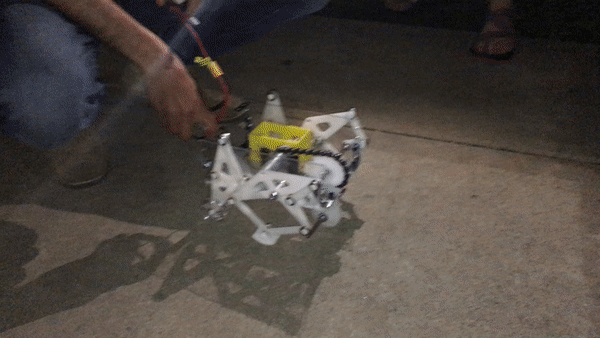
1
Empathize and Define




Point of View Statement:
I am seven years old and want to be amazed without using an electronic device because I need to decrease the amount of time I am staring at a screen and explore the physical world while being entertained.
Chosen Theme: Frogs in a Pond
Ideation
2

Ghassaei Linkage Mechanism


Theo Jansen Linkage Mechanism

Why the Ghassaei Linkage Mechanism Chosen:
-
Smooth gait to minimize internal part movement
-
Fast return mechanism to quickly move walker
Why the Swimming Frog Automaton Chosen:
-
Keep walker's mass close to the ground to avoid the walker falling over
-
Young children understand and are entertained by frogs
-
Children can learn about mechanics by observing visible linkages and gears
Low Fidelity Prototyping and Initial Computer Aided Design
3




*CAD done by Kevin Peralta


*CAD done by Niket Shah
* CAD Assembly done by Niket Shah
Prototype and Design Iteration
4

* CAD Assembly done by Niket Shah

*Assembly done by Kevin Peralta

First Time Walking
*GIF Created By: https://ezgif.com/video-to-gif
Final Prototype and Design
5




* CAD Assembly done by Niket Shah, Frog CAD done by Bertil Jonsonn from GrabCAD


Design Contributions
Why the Automaton was Changed:
-
Old automaton design had difficulties with the gears meshing since gears were sufficiently above the chassis
-
New automaton design has gears that mesh well and produces a fluid movement
-
Simplified the design so more output could be transferred to the legs of the walker
Why the Gearbox was Designed:
-
Keep gears in place and aligned to avoid shifting during walker movement
-
Used to carefully align the bevel gears to ensure transfer of motion to the automaton
-
Precisely lines up the output shaft to the automaton gear
-
Snap fits on top to provide easy assembly and disassembly
Why the Front Wheel was Designed:
-
To increase stability of the walker
-
to stop the walker from falling forward
Why the Foot Attachment was Designed:
-
To increase the surface area under the foot of the walker which increases stability
-
To create a smooth stance phase by creating an "ankle" joint in the walker legs

* CAD Assembly done by Kevin Peralta




Final Results Compared to Intentions
Achievements:
Our final design was within the parameters of our set theme. It still was able to provide mechanical demonstrations to a child while entertaining our user with shapes and colors. Our final automaton told a story. The Ghassaei linkage mechanism provided a smooth gait for our walker.
Practical Limitations:
The original automaton design was not executable because the materials used created too much friction between parts and because the linkages attached to the gears provided an unstable plane for the gears to mesh. The Ghassaei linkage mechanism worked best on flat surfaces; there was not sufficient y-displacement to traverse terrain such as grass.
Room for Improvement:
Improvements for the future would include slightly altering the Ghassaei linkage mechanism link lengths by decreasing the lengths of the links connected to the foot of the leg to increase the y-displacement. The meshing of the automaton gears of the initial design could be improved by choosing different materials, but the materials within our budget cater better to simpler designs, such as the automaton produced for the competition.